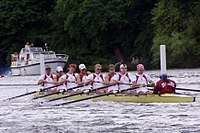
Photo from wikipedia
This study investigated time-courses of physiological and psychological parameters of rowers during the first 1,500 m of a simulated race on a rowing ergometer using different pacing strategies. This provided… Click to show full abstract
This study investigated time-courses of physiological and psychological parameters of rowers during the first 1,500 m of a simulated race on a rowing ergometer using different pacing strategies. This provided a picture of the physiological and psychological state of the rowers at the start of the last 500 m of their race. Investigated strategies corresponded either to a degressive (degr), a progressive (prog), or a stable (stab) power output over the traveled distance. Thirteen French rowers (4 oarswomen and 9 oarsmen) of national and ex-international levels volunteered to participate. Handle force and velocity, oxygen uptake, heart rate, blood lactate concentration, and peripheral oxygen saturation were measured during the trials. Power output, generated energy [by O2 consumption (Eoxi) and blood lactate accumulation (Enon−oxi)] and efficiency were computed. Rowers also rated their perceived exertion (RPE) and protocol preference. In the explored strategies, no significant differences were found for Eoxi. Final blood lactate concentration ([La]blood) and RPE were similar for all strategies. However, the increase in [La]blood and RPE occurred sooner for degr than for stab and prog. Therefore, the time spent at higher [La]blood and RPE was longer for degr than for stab and prog. According to the questionnaire, degr was the least preferred protocol. While during 2000 m races, the first 1500 m are usually and empirically often conducted in a degr way, the present results indicate that this strategy was the least preferred by the rowers and led to a higher time spent at high [La]blood and RPE.
Journal Title: Frontiers in Physiology
Year Published: 2022
Link to full text (if available)
Share on Social Media: Sign Up to like & get
recommendations!